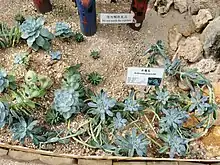Echeveria peacockii
Echeveria peacockii, also known as Echeveria desmetiana in Europe, is in the family Crassulaceae. It is very distinct from all other species, except for Echeveria subsessilis. L. de Smet was the first grower of this plant.[3]
| Echeveria peacockii | |
|---|---|
 | |
| Scientific classification | |
| Kingdom: | |
| (unranked): | |
| (unranked): | |
| (unranked): | |
| Order: | |
| Family: | |
| Genus: | |
| Species: | E. peacockii |
| Binomial name | |
| Echeveria peacockii Croucher [lower-alpha 1][2] | |
Distribution
Echeveria peacockii grows naturally in Mexico. It also grows in California, and can be traced to Dr. J. N. Rose's introduction of the plant.[3]
Habitat and ecology
Echeveria peacockii tends to grow on rocky outcroppings at higher altitudes. In this type of environment, water is drained quickly from the roots of the plant, never allowing the plant to be submerged in water. This plant is fast growing and requires a bright light to prevent stretching, which forms an unhealthy plant.[4]
E. peacockii grows in a warm, dry, sunny climate. They tend to grow in areas that are sometimes covered in shade (cannot tolerate too much sun). The optimal temperature for growth is 20-30℃.[5]
Morphology
This plant has a short stem or none at all. Leaves are numerous (50 or more), crowded, relatively narrow, 5–6 cm long, 20–35 mm wide, and arranged as a rosette. The top of the leaf is flat, bottom of the leaf is rounded and keeled (curved). The leaves are always dusty and crumbly. The peduncle is thick and erect. It has inflorescences of three, secund, 30 cm tall or more. There are few bracts on this plant and they are all very close together, are obovate, acuminate, keeled, are 18 mm thick, and are pruinose. Pedicels are very short (up to 3 mm thick). The sepals are bunched together, unequal in size, are oval-shaped, and grow up to 8 mm long. The corolla is straight grows up to 11 mm long, and 6–7 mm thick. The petals are slightly spreading at tips, sharply keeled, and are hollowed within the base. Nectaries are oblique and 1.5 mm wide.[3]
Flowers
Echeveria peacockii produces 20 or more flowers, and begins to flower in June.
Reproduction
E. peacockii has a chromosome number of n = 15.[3]
Cultivation
Echeveria peacockii is cultivated as an ornamental plant, and often used as a drought-tolerant groundcover "carpet plant".
Notes
- The original publication unhelpfully refers only to a 'Mr. Croucher', who may be impossible to identify.[1]
References
- Baker, J. G. (1874). "New Garden Plants". The Gardeners' Chronicle. 2: 258.
- Tropicos.org. "Echeveria peacockii Croucher". Missouri Botanical Garden. Retrieved 1 Jul 2012.
- Walther, Eric (1972). Echeveria. California Academy of Sciences. pp. 265–266.
- "Echeveria peacockii". Retrieved 2012-06-28.
- Flower Information Network. "Echeveria Peacockii". antisocialmediallc.com. Archived from the original on 8 December 2011. Retrieved 1 July 2012.